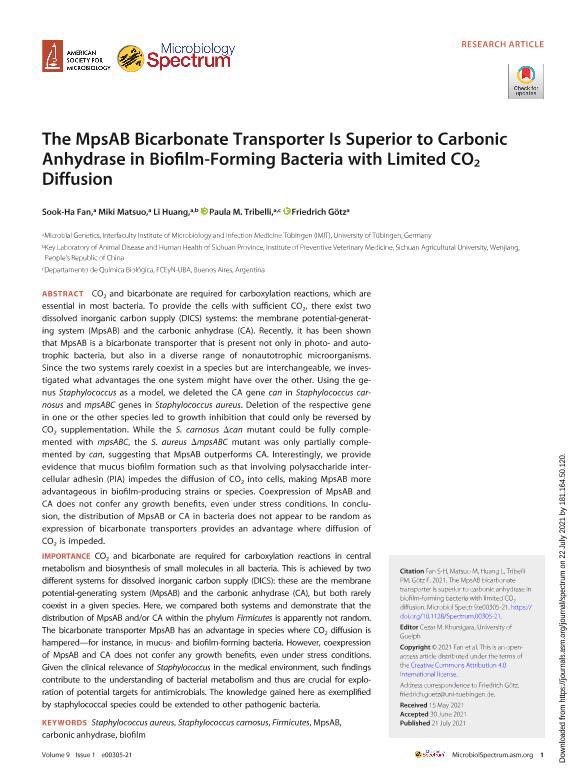Mostrar el registro sencillo del ítem
dc.contributor.author
Fan, Sook Ha
dc.contributor.author
Matsuo, Miki
dc.contributor.author
Huang, Lili
dc.contributor.author
Tribelli, Paula Maria

dc.contributor.author
Götz, Friedrich
dc.date.available
2023-01-05T17:54:12Z
dc.date.issued
2021-07
dc.identifier.citation
Fan, Sook Ha; Matsuo, Miki; Huang, Lili; Tribelli, Paula Maria; Götz, Friedrich; The MpsAB Bicarbonate Transporter Is Superior to Carbonic Anhydrase in Biofilm-Forming Bacteria with Limited CO 2 Diffusion; American Society for Microbiology; Microbiology Spectrum; 9; 1; 7-2021; 1-17
dc.identifier.issn
2165-0497
dc.identifier.uri
http://hdl.handle.net/11336/183579
dc.description.abstract
CO2 and bicarbonate are required for carboxylation reactions, which are essential in most bacteria. To provide the cells with sufficient CO2, there exist two dissolved inorganic carbon supply (DICS) systems: the membrane potential-generating system (MpsAB) and the carbonic anhydrase (CA). Recently, it has been shown that MpsAB is a bicarbonate transporter that is present not only in photo- and auto-trophic bacteria, but also in a diverse range of nonautotrophic microorganisms. Since the two systems rarely coexist in a species but are interchangeable, we investigated what advantages the one system might have over the other. Using the genus Staphylococcus as a model, we deleted the CA gene can in Staphylococcus car-nosus and mpsABC genes in Staphylococcus aureus. Deletion of the respective gene in one or the other species led to growth inhibition that could only be reversed by CO2 supplementation. While the S. carnosus Δcan mutant could be fully complemented with mpsABC,the S. aureus ΔmpsABC mutant was only partially complemented by can, suggesting that MpsAB outperforms CA. Interestingly, we provide evidence that mucus biofilm formation such as that involving polysaccharide intercellular adhesin (PIA) impedes the diffusion of CO2 into cells, making MpsAB more advantageous in biofilm-producing strains or species. Coexpression of MpsAB and CA does not confer any growth benefits, even under stress conditions. In conclusion, the distribution of MpsAB or CA in bacteria does not appear to be random as expression of bicarbonate transporters provides an advantage where diffusion of CO2 is impeded. IMPORTANCE CO2 and bicarbonate are required for carboxylation reactions in central metabolismandbiosynthesisofsmallmoleculesinallbacteria.Thisisachievedbytwo different systems for dissolved inorganic carbon supply (DICS): these are the membrane potential-generating system (MpsAB) and the carbonic anhydrase (CA), but both rarely coexist in a given species. Here, we compared both systems and demonstrate that the distribution of MpsAB and/or CA within the phylum Firmicutes is apparently not random. The bicarbonate transporter MpsAB has an advantage in species where CO2 diffusion is hampered—for instance, in mucus- and biofilm-forming bacteria. However, coexpression of MpsAB and CA does not confer any growth benefits, even under stress conditions. Given the clinical relevance of Staphylococcus in the medical environment, such findings contribute to the understanding of bacterial metabolism and thus are crucial for exploration of potential targets for antimicrobials. The knowledge gained here as exemplified by staphylococcal species could be extended to other pathogenic bacteria.
dc.format
application/pdf
dc.language.iso
eng
dc.publisher
American Society for Microbiology

dc.rights
info:eu-repo/semantics/openAccess
dc.rights.uri
https://creativecommons.org/licenses/by-nc-sa/2.5/ar/
dc.subject
BIOFILM
dc.subject
CARBONIC ANHYDRASE
dc.subject
FIRMICUTES
dc.subject
MPSAB
dc.subject
STAPHYLOCOCCUS AUREUS
dc.subject
STAPHYLOCOCCUS CARNOSUS
dc.subject.classification
Biología Celular, Microbiología

dc.subject.classification
Ciencias Biológicas

dc.subject.classification
CIENCIAS NATURALES Y EXACTAS

dc.title
The MpsAB Bicarbonate Transporter Is Superior to Carbonic Anhydrase in Biofilm-Forming Bacteria with Limited CO 2 Diffusion
dc.type
info:eu-repo/semantics/article
dc.type
info:ar-repo/semantics/artículo
dc.type
info:eu-repo/semantics/publishedVersion
dc.date.updated
2022-09-22T00:28:16Z
dc.journal.volume
9
dc.journal.number
1
dc.journal.pagination
1-17
dc.journal.pais
Estados Unidos

dc.description.fil
Fil: Fan, Sook Ha. Eberhard Karls Universität Tübingen.; Alemania
dc.description.fil
Fil: Matsuo, Miki. Eberhard Karls Universität Tübingen.; Alemania
dc.description.fil
Fil: Huang, Lili. Eberhard Karls Universität Tübingen.; Alemania
dc.description.fil
Fil: Tribelli, Paula Maria. Consejo Nacional de Investigaciones Científicas y Técnicas. Oficina de Coordinación Administrativa Ciudad Universitaria. Instituto de Química Biológica de la Facultad de Ciencias Exactas y Naturales. Universidad de Buenos Aires. Facultad de Ciencias Exactas y Naturales. Instituto de Química Biológica de la Facultad de Ciencias Exactas y Naturales; Argentina
dc.description.fil
Fil: Götz, Friedrich. Eberhard Karls Universität Tübingen.; Alemania
dc.journal.title
Microbiology Spectrum
dc.relation.alternativeid
info:eu-repo/semantics/altIdentifier/doi/http://dx.doi.org/10.1128/Spectrum.00305-21
Archivos asociados
